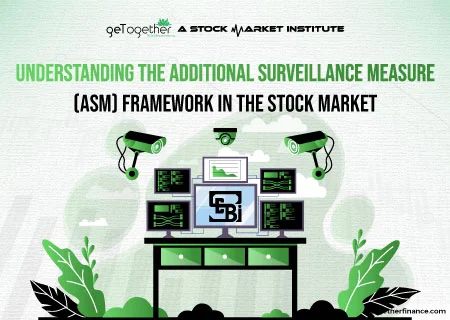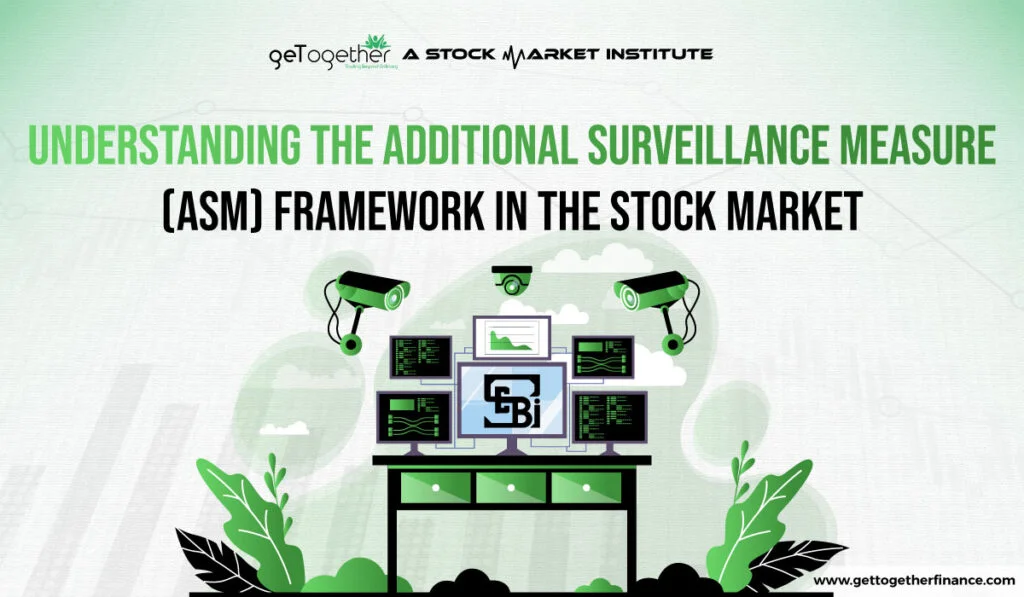Understanding the Additional Surveillance Measure (ASM) Framework in the Stock Market


Table of Contents
ToggleIntroduction
The Additional Surveillance Measure (ASM) Framework is a regulatory framework curated by SEBI to enhance the stock market integrity and protect investor’s interests. Its primary purpose is to watch out and reduce the volatility and speculative trading in the highlighted stocks.
By implementing Additional Surveillance Measures , like higher trading margin requirements and trading restrictions, the ASM framework aims to reduce market manipulation and reduce systemic risks involved in the trading activities of those securities.
The Additional Surveillance Measure framework is necessary for ensuring fair play and orderly market transactions; it ensures that the prices of selected securities are driven by genuine demand and supply rather than speculative forces. This way, in the stock market, the ASM framework plays a vital role in promoting transparency, protecting retail investors from unnecessary risks, and Maintaining overall market stability by monitoring price fluctuations and potential fraud.
What is ASM (Additional Surveillance Measure)

Let’s understand how ASM was introduced and how it’s helping investors with the support of authorities.
Origin and Development
The Additional Surveillance Measure (ASM) Framework was introduced in the Indian stock market to address market anomalies and ensure that fair trade practices are there in the market. It was implemented in 2018 by the SEBI in collaboration with top stock exchanges like NSE, and BSE. This framework was curated to tackle the growing concerns about extreme volatility in the stock market and speculative trading done by manipulators.
Key Milestones
From the time Additional Surveillance Measure was introduced, the framework has undergone several enhancements to adapt to market dynamics and serve its purpose the best. One of its key milestones happened in March 2018. At that time SEBI gave periodic updates to inclusion and exclusion criteria, and the introduction of additional measures like graded surveillance and dynamic margin requirements. These regulations showed regulatory authorities’ continuous efforts to safeguard the framework based on market feedback, sentiments, and evolving trading patterns.
Securities and Exchange Board of India (SEBI)
SEBI, the key regulatory authority of the securities market in India, manages the ASM framework. SEBI’s primary focus is to protect investor’s interests, promote market development, and regulate market intermediaries transparently.
Stock Exchanges (NSE, BSE, etc.)
The NSE and BSE are India’s leading stock exchanges, they played a pivotal role in implementing the Additional Surveillance Measure Framework. These stock exchanges identify the securities that need to be put under ASM, enforce surveillance measures on them, and ensure compliance with SEBI guidelines. These exchanges work in a comprehensive way with SEBI and watch the market activity. Further, they adjust the framework as necessary to address emerging risks and challenges.
The coordination between SEBI and stock exchanges enables a strong surveillance framework, preserving market integrity and investor confidence.
Also Read: ASM and GSM
Which Stock Comes Under ASM

Criteria for ASM
The Additional Surveillance Measure framework uses the well-set criterion to decide which security is eligible enough to watch closely. This criterion is designed to help mitigate unnecessary volatility in the market and reduce market speculation.
Financial Metrics
- Price Variation
One of the primary triggers for this framework is the unusual price variations. Stocks that show abnormal and continuous price movements in an upward or downward direction are subjected to close monitoring. This helps in identifying the stocks that may be susceptible to manipulation and speculative trading.
- Market Capitalization
Stocks with smaller market caps are usually under low liquidity, which makes them easy to manipulate. The ASM framework considers the market cap of the companies to assess their susceptibility toward speculative activities, ensuring that smaller, riskier stocks receive additional scrutiny.
Trading Activity
- Volume and Turnover
High trading volume and rates may indicate fraudulent activity in the stock. The ASM framework closely analyzes daily trading volume and stock turnover to detect unusual activity. The sudden increase in volume, which is not supported by the infrastructure, can cause ASM to fail.
- Corporate Governance and Compliance
Stocks associated with companies having poor corporate governance and regulatory operations are easily subjected to manipulation. The ASM assesses certain factors such as board composition, transparency in financial reporting, adherence to regulatory requirements, and past violations. Companies having dicey and weak governance and questionable compliance records are placed under the category of additional surveillance to protect investor’s interests.
The ASM framework uses these principles to establish a safer and more transparent trading environment, safeguarding investors from the dangers associated with volatile and speculative stocks.
Types of (ASM) Frameworks

There are two types of ASM Frameworks
Short-term ASM
Short-term Additional Surveillance Measure focuses on the immediate and dynamic market conditions that may cause uncertain volatility in stocks. This framework is typically triggered by short-term price movement in a significant number, where the trading volumes seem unusual compared to the time it occurred. Short-term ASM includes increased margin requirements, reduced price bands, and additional obligations to reduce excessive speculation and constant price volatility.
The goal of this framework is to stabilize the stock price quickly and protect investors from potential market manipulation or uncertain trading behavior. Stocks that are put under short-term ASM are under watch periodically by SEBI, and measures can be lifted once the volatility is reduced.
Long-term ASM
Stocks that exhibit consistent patterns of risk for a long period of time are kept under Long-term Additional Surveillance Measure . These risks might include uncertain high volatility and unusual and significant price variations accompanied by weak corporate governance and financial health. LTASM may include high-margin requirements, restrictions on intraday trading, and enhanced disclosure requirements for the stock that comes under it. The whole-sole objective of LTASM is to make sure that market integrity is sustained and investors’ interests are protected. Stocks under long-term ASM are closely monitored by SEBI, and the measures remain in place until the listed risk is managed and reduced to a convincing point. This framework aids in maintaining a stable trading environment for securities that are prone to protracted speculative activity or systemic difficulties.
Both types of ASM frameworks play critical roles in preserving market stability, protecting investors, and ensuring fair trading procedures by addressing various degrees and durations of market risk.
What Happens to Stocks that Come under ASM

Now that you’ve understood what ASM is, its types, and how it works, let’s know what happens to stocks that come under it.
Trading Restrictions
When the stock comes under Additional Surveillance Measure certain trading restrictions are imposed on it to mitigate speculation and volatility. These restrictions might include the limited price range that is open for trading, certain restrictions under intraday trading, or maybe fully banning intraday trading, making stock only available in delivery trading.
Margin Requirements
Various brokers provide the margin facility to the traders, implying that they can get holdings by paying a certain percentage of the whole capital required. But, for the stocks that come under ASM, the margin requirement can be increased. This implies that traders must pay a higher percentage of the capital as a deposit. Higher margin requirements make trade more expensive, lowering participation in trading activities. This intends to lower the speculation and stabilize its price.
Additional Reporting Obligations
Companies whose stock comes under Additional Surveillance Measure need to fulfill additional reporting obligations to stock exchanges and SEBI. It implies that these companies need to provide detailed documents and proof regarding their financial health, profit statements, business activities, and other relevant activities. These disclosures help maintain transparency with investors, in turn helping in informed investing. Increased reporting about the financial performance of the company market has up-to-date information about its working, reducing probable uncertainty and speculation.
Should I Invest in Companies Listed Under ASM

Investing in companies listed under the Additional Surveillance Measure (ASM) framework requires careful consideration. Here are some factors to keep in mind:
Risks of Investing ASM Companies
1. High Volatility: Companies that come under Additional Surveillance Measure are often susceptible to significant price fluctuations, making their stock prices unpredictable.
2. Speculative Trading: These stocks are usually into speculation and manipulation, making them into pump and trading.
3. Stricter Trading Rules: Often higher margin is required to trade these stocks, which reduces the flexibility traders have in trading, especially in intraday. This can affect liquidity and make it harder to sell shares quickly if needed.
Potential Opportunities
1. Undervalued Stocks: Sometimes due to unpredicted market anomalies, fundamentally and technically strong companies are also placed under Additional Surveillance Measure, making them undervalued. If the company’s technicals, as well as fundamentals, are strong, this could be an opportunity to buy at a lower price.
2. Increased Transparency: additional reporting obligations imposed by SEBI can help in getting frequent updates about the company’s financial health and activities, allowing investors and traders to make informed decisions.
Considerations
Do Your Research: Never believe everything you see on the news, research the company you want in it well, and know the probable reasons why it is put in the ASM Framework. If the reasons aren’t strong enough the stocks are looking to go with your analysis, then you can buy the stock irrespective of its current obligations.
Risk Tolerance: Before entering into trade or investing, define your risk tolerance. Getting into ASM-listed stocks can be riskier sometimes, so ensure it aligns with your analysis and investment strategies.
Diversification: Never commit the mistake of putting all your money into ASM-listed stocks. Diversify your investments to mitigate the risks of your portfolio.
To summarize, while ASM-listed stocks may offer good opportunities they also carry increased risk. Before investing in these companies, you should conduct thorough research and determine your risk tolerance.
Conclusion
The Additional Surveillance Measure (ASM) framework is critical in ensuring market stability and protecting investors from excessive volatility and speculative trading. By imposing greater margin requirements, trading limitations, and additional reporting requirements, the Additional Surveillance Measure framework assures that stock prices reflect true market demand and supply rather than manipulative factors. While investing in ASM-listed stocks can provide possibilities, particularly if the company is fundamentally solid, it also brings additional dangers due to increased volatility and trading restrictions. As a result, before investing in such equities, one must conduct extensive research and carefully examine their risk tolerance. To summarize, the ASM framework is critical for maintaining a transparent and fair trading environment, which promotes investor trust and overall market integrity.
Frequently Asked Questions
What is the main goal of the Additional Surveillance Measure (ASM) framework?
The ASM framework attempts to improve market integrity and protect investors by limiting volatility and speculative trading in specific equities. It imposes measures such as greater margin requirements and trading limitations to ensure that stock prices are influenced by actual market factors rather than manipulative practices.
Which stocks come under Additional Surveillance Measure?
Stocks are chosen based on certain criteria such as unusual price fluctuations, high trading volumes, a small market capitalization, poor corporate governance, and regulatory concerns. The ASM methodology assesses these criteria to identify stocks that may be subject to manipulation or speculative trading.
What’s the difference between short-term and long-term ASM?
Short-term ASM handles quick and transient market situations that result in large price fluctuations or exceptional trading volumes. Long-term ASM focuses on companies with consistent risk patterns over time, such as persistent high volatility and poor corporate governance. Both types impose policies aimed at stabilizingṣ stock prices and protecting investors.
What happens to stocks that come under the ASM framework?
ASM-listed stocks are subject to trading limitations, higher margin requirements, and additional reporting duties. These policies seek to limit speculative trading, reduce volatility, and increase transparency, allowing investors to make informed decisions based on accurate and up-to-date information.
Can I invest in stocks listed under ASM?
Investing in ASM-listed equities carries greater risk owing to increased volatility and trading restrictions. However, there may be chances if the company’s fundamentals are sound. To mitigate any risks associated with Additional Surveillance Measure listed equities, you must undertake extensive research, establish your risk tolerance, and diversify your investment portfolio.



 Instagram
Instagram
